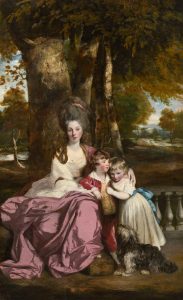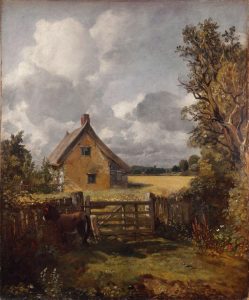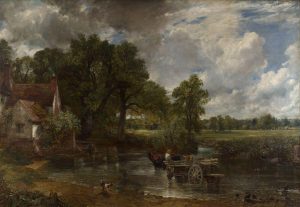10.2 Real Countryside
Two Landscapes depicting the British countryside. What do you think? How do they differ? How do their goals differ?
 |
 |
| Joshua Reynolds. (1777). Lady Elizabeth Delmé and Her Children. Oil on canvas | John Constable. (1833). Cottage in a Cornfield. Oil on canvas. |
Consider the Reynolds. Can you see features that suggest a Neo-Classical style? What role does the Landscape play? It’s really part of the Portrait, isn’t it? The Delmés are portrayed in the parkland of their elegant country estate, a major part of their social identity. This is clearly a work commissioned by an aristocratic family to proclaim its wealth and social standing to the world.
The Constable also portrays a home in the British countryside. But this one is a cottage, a very humble residence traditionally used by peasants who worked the land owned by the lord or squire. It does not portray people. But it does convey a quiet dignity to the life lived by these people. And it dares to find Aesthetic value in depicting the modest building and its surroundings.
What have we learned about Landscapes? Well, the Chinese and the Romantics used them to inspire Sublime visions. Renaissance painters placed them as backdrops behind portraits and biblical paintings. The elite academies of artists valued them well below the honored Genres: Historical Paintings and Portraits. Thus they tended to be used to enhance a view of highly honored people: aristocrats or seers.
The social upheavals of the 19th Century, however, were changing the class system of Europe. Traditional European prestige was based on land ownership and aristocratic birth. Increasingly, what mattered was wealth, even if it had been accumulated “in trade,” financial enterprises that were socially unacceptable for the traditional nobility.
The result was a shift in subject matter. People of the middle and lower orders were becoming increasingly important to the economy and increasingly legitimate as subjects of art. Born to the non-aristocratic merchant class, Constable took as his subject the East Anglia world he grew up in. Not focused solely on gaining commissions from the wealthy, he painted picturesque scenes that meant something to him.
 |
 |
 |
| The Cornfield. (1821). Oil on canvas. | The Hay Wain. (1821). | Dedham Lock and Mill. (1820). Oil on canvas. |
Constable is not particularly easy to pin down. His elegiac view of the British countryside shares the nostalgic affection for the past characteristic of Romanticism, but not its extravagant colors and dramatic action. His embrace of common life shares the interests of Realism, but not its cold commitment to negative aspects of common people’s experience. Constable’s compositions are steeped in the quiet stability of traditional England, and one can feel the love he had for a Suffolk way of life that remained stable through many centuries.
“These dark Satanic Mills.”
Yet Constable’s beloved English countryside was under duress. Industrialization was transforming bucolic landscapes into bleak dead zones. William Blake’s resistance to the age of science and industry was fueled in part by a keen awareness of the cost to the countryside. His song, “Jerusalem,” refers to a tradition which held that Christ had visited “England’s mountains green.” He then asks whether industrialization’s predations on the countryside are building Jerusalem or something else?
William Blake. (1810). Jerusalem.
And did those feet in ancient time
Walk upon England’s mountains green:
And was the holy Lamb of God,
On England’s pleasant pastures seen!
And did the Countenance Divine,
Shine forth upon our clouded hills?
And was Jerusalem builded here,
Among these dark Satanic Mills?
Bring me my Bow of burning gold:
Bring me my arrows of desire:
Bring me my Spear: O clouds unfold!
Bring me my Chariot of fire!
I will not cease from Mental Fight,
Nor shall my sword sleep in my hand:
Till we have built Jerusalem,
In England’s green & pleasant Land.
Our world today abounds with concerns for the impact of industry on our environment. In 1801, Philippe Jacques de Loutherbourg was already casting a ghastly vision of the sulfurous impact of coal fire.
 |
| Phillipe Jacques de Loutherbourg. (1801). Coalbrookdale by Night. Oil on canvas. |
References
Blake, W. (1810). Jerusalem. Preface to Milton a Poem. Poetry Foundation https://www.poetryfoundation.org/poems/54684/jerusalem-and-did-those-feet-in-ancient-time
Brion, M. (1966). Art of the Romantic Era. Romanticism. Classicism. Realism. New York, NY: Frederick A. Praeger.
Constable, J. (1821). The Cornfield [Painting]. London, UK: The National Gallery. AN NG130. https://www.nationalgallery.org.uk/paintings/john-constable-the-cornfield
Constable, J. (1833). Cottage in a Cornfield [Painting]. London UK: Victoria and Albert Museum. https://collections.vam.ac.uk/item/O80700/the-cottage-in-a-cornfield-oil-painting-constable-john-ra/
Constable. (1820). Dedham Lock and Mill [Painting]. London, UK: Victoria and Albert Museum. https://collections.vam.ac.uk/item/O79599/dedham-lock-and-mill-oil-painting-constable-john-ra/
Constable, J. (1821). The Hay Wain [Painting]. London, UK: The National Gallery. AN NG1207. https://www.nationalgallery.org.uk/paintings/john-constable-the-hay-wain
Reynolds, J. (1777). Lady Elizabeth Delmé and Her Children [Painting]. Washington D.C. National Gallery of Art. AN 1937.1.95. https://www.nga.gov/artworks/102-lady-elizabeth-delme-and-her-children
Loutherbourg, P-J. (1801). Coalbrookdale by Night [Painting]. London, UK: Science Museum. https://collection.sciencemuseumgroup.org.uk/objects/co65204/coalbrookdale-by-night-by-philippe-jacques-de-loutherbourg
a visual composition that represents outdoor scenery that may or may not include human structures. Often an exercise in perspective and depth of field, with receding zones: foreground, middle distance, and deep distance.
a style of art that emulates a former classical age, generally emphasizing conventional rules, mathematical precision, and reason over passion
in visual art, a composition that represents a human subject as an individual, meticulously capturing physical or psychological likenesses
the dimension of an artistic experience that appeals to or challenges an au-dience’s sense of taste and experience of beauty, ugliness, the sublime, etc. A response distinct from “interested” concerns such as ideology, sexuality, social conflict or economics
committed to the late 18th and 19th Century reaction against Neo-Classical reason which sought to liberate the individual human imagination and embrace its passions, dreams, and irrational visions as sources of wisdom.
a particular type of composition marked by expected, conventional features: e.g. Japanese haiku, Chinese landscape painting, Renaissance sonnet
A) a reaction against Neo-Classical Reason that seeks to liberate the individual human imagination and embrace its passions, dreams, and irrational visions as sources of wisdom. B) as an aesthetic, a rejection of strict artistic rules and convention in favor of organic form and innovation. C) often, advocacy for folk traditions that have been despised by classical elites
an attitude of disillusioned skepticism which in art strives to represent reality as it is, questioning cultural myths and ideologies and including uncomfortable subjects that conventional art tends to overlook
